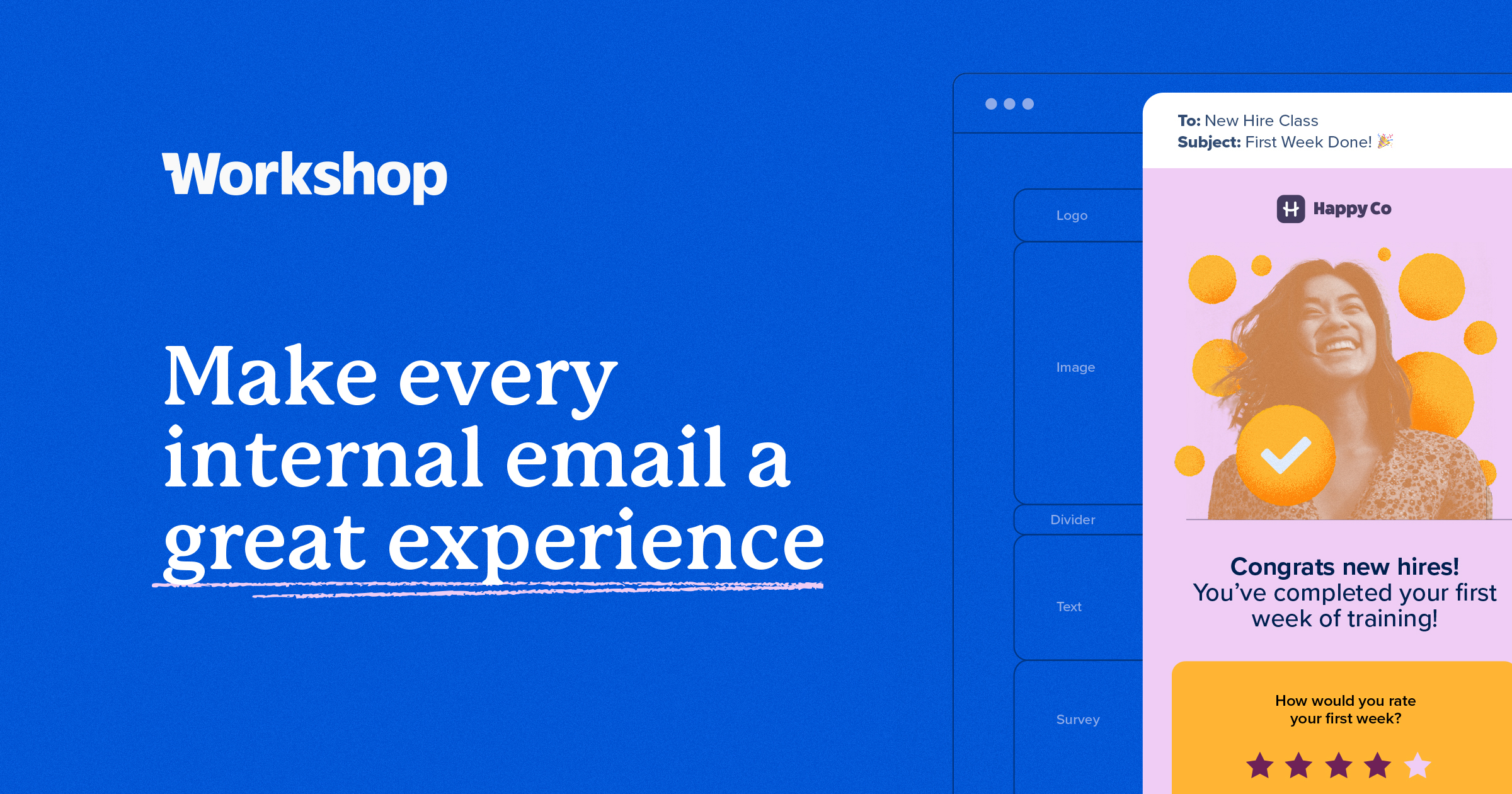Can you use Hubspot for internal communications?

As a communications professional, you’re probably used to the idea of “making it work” with the tools and budget you have at your disposal.
Many times, that’s whatever email tool the marketing team is already using for external communications: Hubspot, Salesforce, Marketo, Campaign Monitor, Emma, etc. But when it comes down to it: can you use Hubspot for internal communications? Or, perhaps more importantly: should you use Hubspot for internal communications?
Why use Hubspot for internal communications?
There are some pros: we consider it a “step up” from not using any email solution at all, and it’s pretty easy to see the appeal. If you’re creating newsletters in Canva, designing PDFs that you’re just attaching, or sending out emails that are built entirely in Outlook…then of course, Hubspot’s email editor and analytics can certainly seem like an attractive offer. It’s a much better way to create visually engaging, trackable internal emails.
For operational and financial purposes, there’s a consolidation factor: after all, if the marketing team is already using the platform, that’s one less piece of software to manage. Hubspot’s cost does scale with the more contacts that you add to it, however…so even though you may be saving some money by not using an additional tool, you may still be paying a lot more than you want to for your employee contacts (especially if you have more than 1,000).
And for external marketing, you won’t find a bigger Hubspot fan than me. It’s the first piece of software I ask for in any startup, and it’s an absolute must-have. Nothing beats it. But I don’t want to mix in my internal communications: it affects my analytics across the board, it gives employees the option to unsubscribe, and I have to have someone manually manage those employee lists. So, really, the cost winds up being far higher. (We’ll dig in more in this next section!)
Why Hubspot doesn’t work for internal communications
While Hubspot and other email marketing tools are absolutely amazing for sending communications to prospects and customers, they were never intended for internal, employee-facing use cases. As a result, they can (and will) present serious barriers to your day-to-day work, and they will affect the way your employees receive information. At the end of the day, it can significantly hinder the success of your comms efforts.
Here are some of the top reasons why companies choose a dedicated internal communications email platform instead. And if you are already using Hubspot or a similar tool for internal communications, it’s very likely that you’ve run into one (or many) of these logistical issues already:
- Distribution lists: A tool like Workshop actively syncs with your employee data sources (whether that’s in AD or your HR/payroll system) so your lists are always up-to-date and you don’t have to manually add or remove employees.
- Security: These platforms automatically create links to every email that are viewable by anyone, anywhere.
- Deliverability: Often, emails sent from these providers wind up in employees’ spam or promotional folders in their inboxes. Plus, they can even unsubscribe….yikes!
- Analytics: With Workshop, you can segment your data by department, location…even drill down and see exactly which employees are engaging with the email.
- Integrations: We connect to the tools and channels that internal communicators use (Slack, Sharepoint, Teams, etc.), rather than the ones that external marketers use (Hubspot, Facebook, Instagram, etc.).
- Usability: You don’t need to have expert-level HTML knowledge to create a really beautiful, branded email template. Workshop’s drag-and-drop email editor is incredibly easy to use (our customers tell us it literally saves them hours each week).
- Misc. features: Since Workshop was created with internal communications in mind, we have added features like SMS integrations and embeddable pulse surveys to make your workflow even easier.
Still not sure? We’ll dig into each of these key areas as we go (and we’ll tackle the budget concerns, as well)!
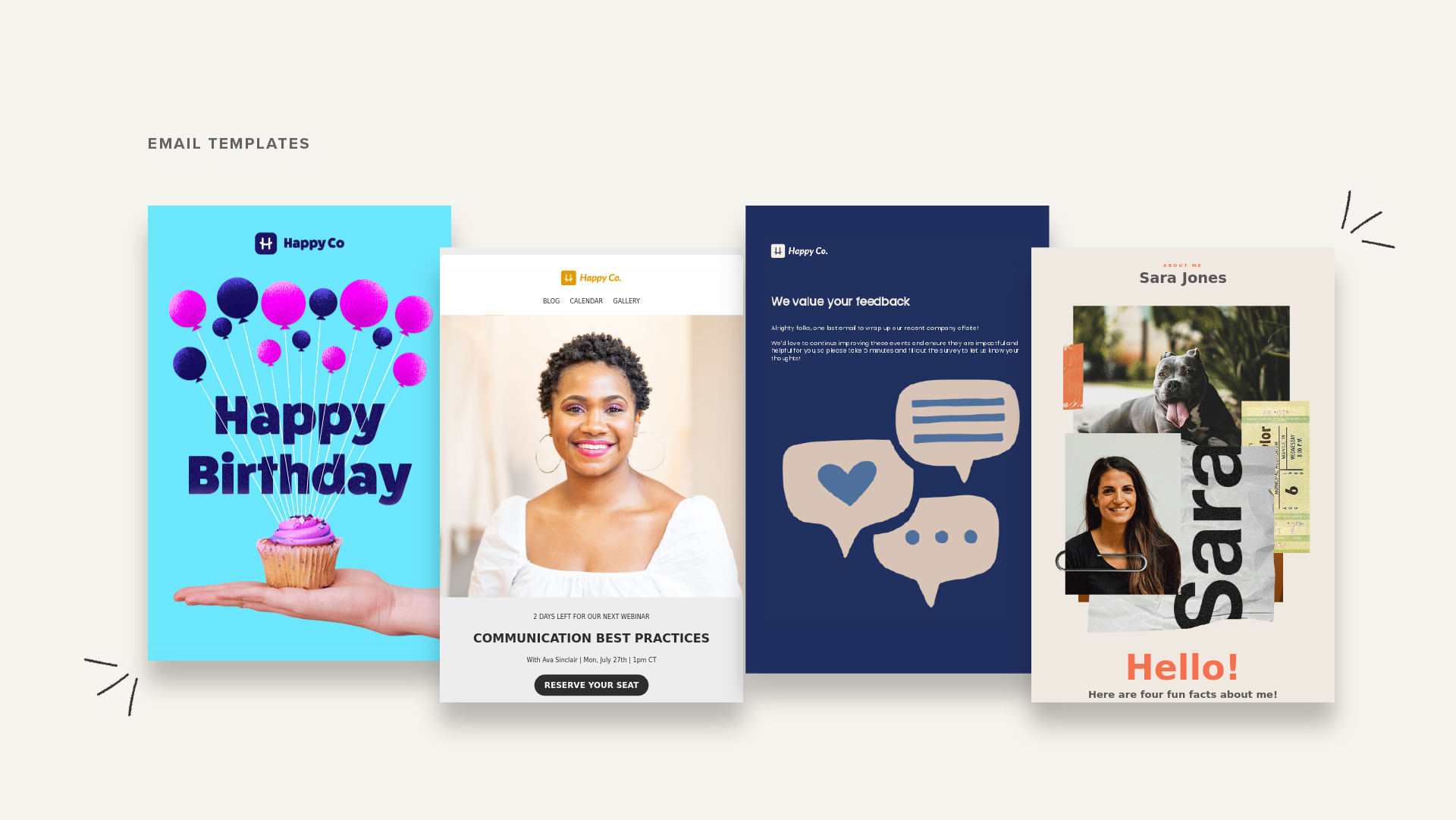
Marketing and internal communications shouldn’t share tools (even if they share tactics)
There are a plethora of reasons why external marketing and internal communications shouldn’t share tools, even if many of the ideas driving the communication are the same.
Here’s a quick-and-simple look of some of the main head-to-head differences between an internal communications platform like Workshop and an external email marketing platform like Salesforce, Constant Contact, Hubspot, or Marketo:
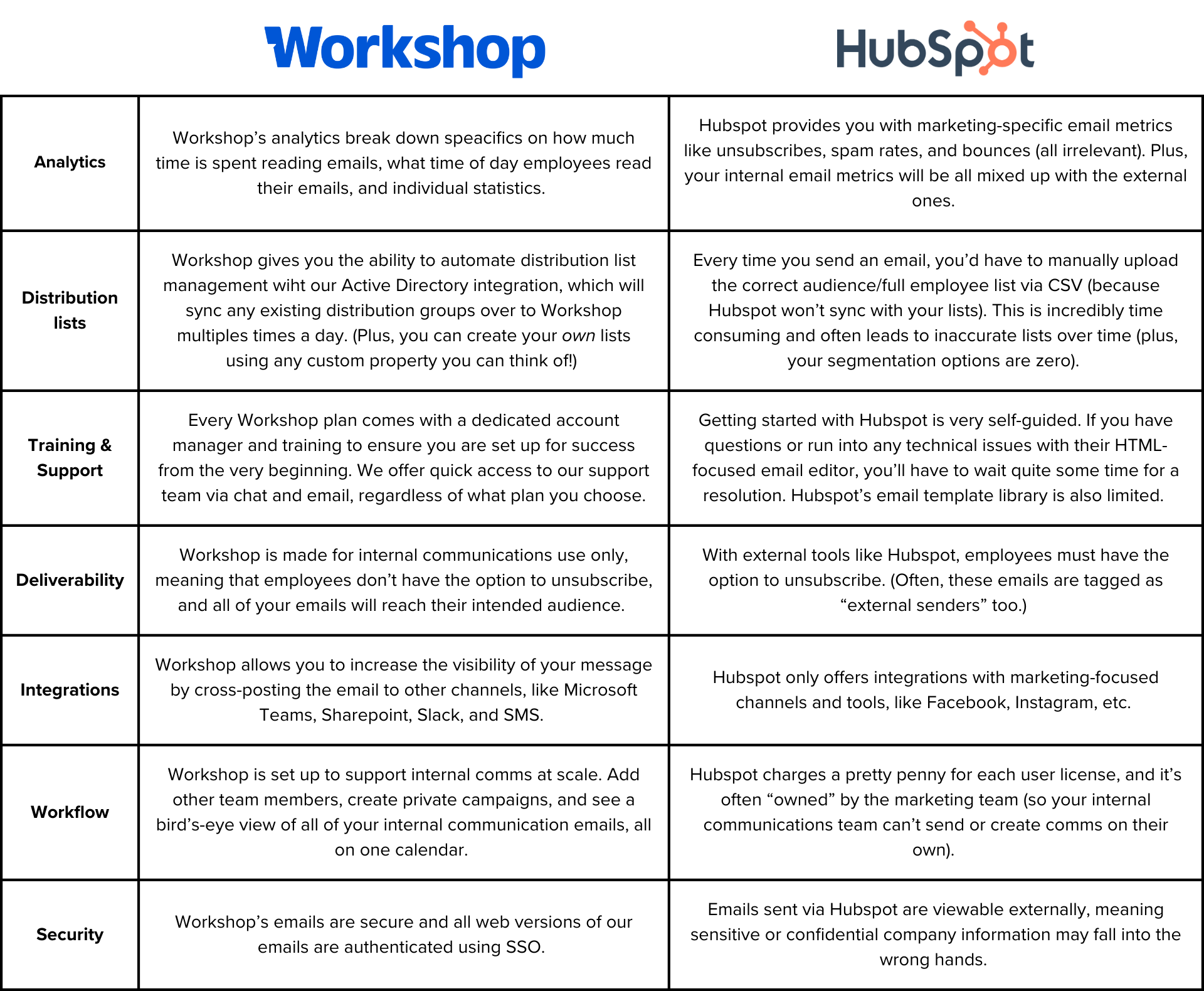
Let’s explore each of them in-depth!
1.) Distribution lists
An external email marketing platform is designed to tackle a huge list of contacts with very little management and minimal data. The contacts are meant to be a dime a dozen; you aren’t supposed to be able to manage the level of data that you get with employee information: locations, roles, departments, start dates, benefits packages, you name it. As a result, they aren’t set up to sync with employee data sources at all, and you’re left manually managing distribution lists every single time you need to send a new piece of communication. Even if those distribution lists are set up really well in your Microsoft or Google business accounts, it doesn’t matter — you’re unable to set up that data to sync with Hubspot.
One of the best ways we can illustrate this problem: new hire onboarding, and employee attrition. In the case of each employee joining or leaving the company, updating the “all company” employee list in platforms like HubSpot or Salesforce becomes a manual task. While this may seem manageable for smaller organizations with around 100 employees, the burden becomes significantly cumbersome as the workforce expands beyond 250 employees. External marketing platforms often complicate matters, requiring numerous steps just to upload a new CSV of contacts. Moreover, inadvertently omitting an employee can lead to potentially serious consequences. The struggle intensifies as your organization grows, underscoring the need for a more streamlined solution.
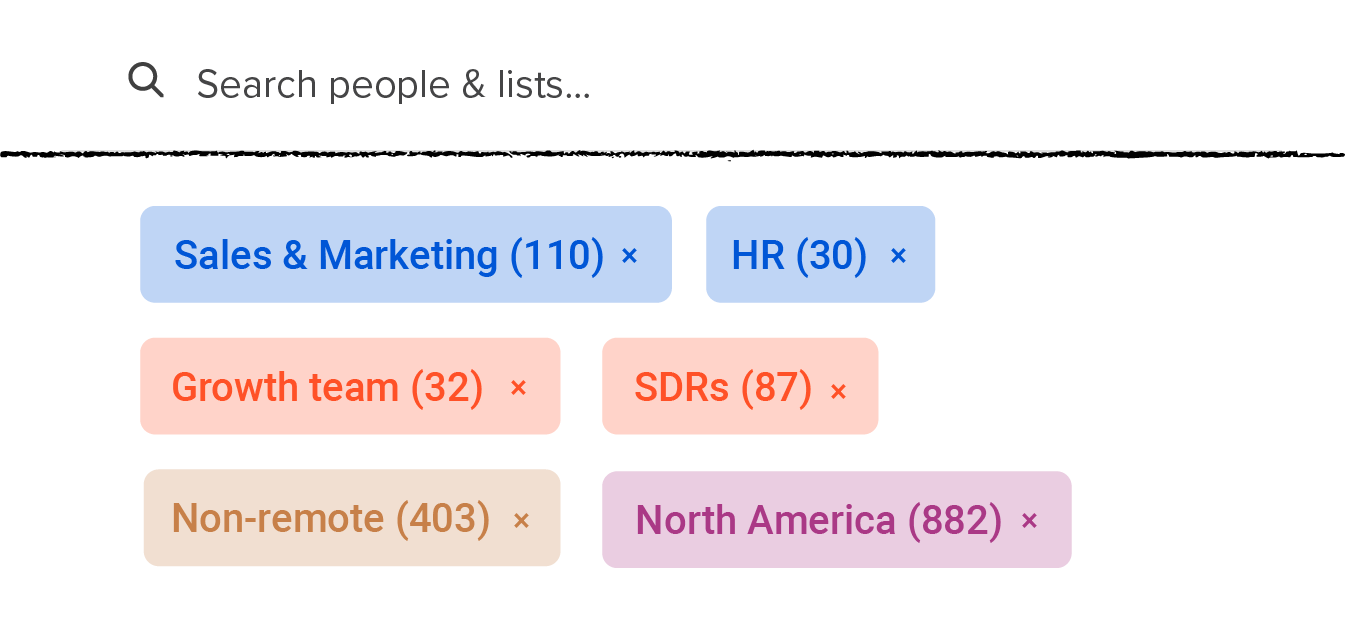
This is an area where an internal communications platform like Workshop absolutely excels. We offer more HRIS integrations than any other solution out there, so we can connect to whatever source has the most up-to-date information for your employees: whether that’s Active Directory, Outlook, Google, Workday, ADP, your payroll software, you name it. That means your lists will always be ready for you to use, and you can filter them by the information and fields that truly matter to you (like location, department, or role). And, if you need to do a one-off send to a specific list, it just takes a couple of clicks to set it up.
2.) Security
We spend a lot of time talking with IT teams, but one thing always stands out to us as a surprise: many are unaware of the potential security risks associated with using external email software for internal communications. Notably, platforms such as Salesforce, Constant Contact, HubSpot, and Marketo automatically generate web links for every email, accessible to anyone, anywhere. From a data integrity standpoint, concerns arise about who else might have unauthorized access to internal communications and where the data is actually stored.
Opting for an internal communications platform like Workshop ensures the security of your emails. If you want a web version of your email, that version will always require authentication through Single Sign-On (SSO). Moreover, our commitment to compliance, reflected in our SOC-2 and GDPR certifications, adds an extra layer of assurance. Your internal communications will now be more secure than ever.
3.) Deliverability
In a nutshell, they cancelled the service because too many employees were unsubscribing. That’s a huge difference between an external marketing and internal communications platform: the external platforms have to include an unsubscribe option:
“Hubspot is required to enforce anti-spam laws, including the U.S. CAN-SPAM Act. This means you must include an unsubscribe link in your email campaigns.”
There are solid reasons behind this practice: in the realm of marketing communications, providing an opt-out option is a must. However, when it comes to crucial information like benefits details, COVID-19 policies, significant updates from the CEO, or legal communications, the last thing we want is employees opting out. Given that Workshop is exclusively dedicated to internal communications, the default setting does not include an unsubscribe link.
Dealing with unsubscribes is challenging on its own, but the struggle doesn’t end there. Frequently, emails sent through platforms such as Salesforce, Constant Contact, HubSpot, and Marketo find themselves relegated to employees’ spam or promotional folders in their inboxes – primarily because they resemble marketing content. (Many times, these get tagged with an “external sender” flag, too!)

4.) Data and analytics
Hubspot provides you with marketing-focused metrics, including unsubscribes, bounces, and spam scores (all irrelevant for internal communications). This information is typically all mixed in with the rest of the marketing team’s email analytics, and it can be difficult to segment the information you want out of it.
Workshop’s analytics break down specifics on how much time is spent reading emails, what time of day employees read their email, and individual statistics so you can see exactly who read the email and who didn’t. On top of that, you can filter your data by any list you’d like (including location, department, role, or any custom one you’ve created, like full-time or frontline employees).
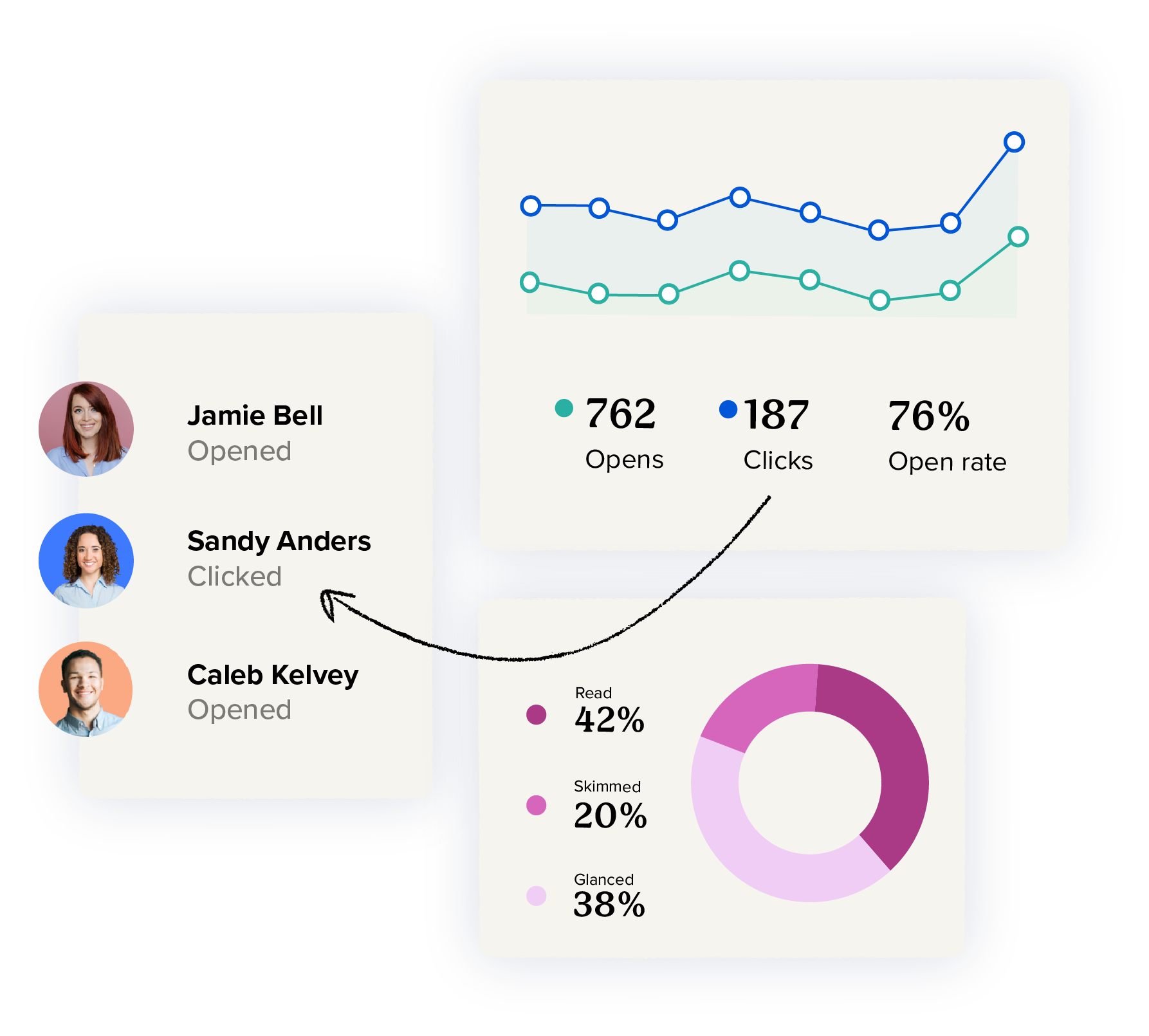
5.) Integrations
In terms of toolset, the difference between marketing and internal communications is huge. The tools and channels that external marketing efforts require is vastly different. For marketers, you’ll want your email tool to integrate with social media channels, advertising platforms, sales tools, the marketing site, etc. But for internal communications, you’re looking to connect to internal messaging tools (Slack, Teams, your intranet, etc.), your HR system, employee phone numbers, etc. The capabilities just don’t exist in a platform like Hubspot to create this strategy for multi-channel distribution, but they do exist (and thrive!) in Workshop.
6.) Usability
While most marketing teams have the luxury of a dedicated graphic or web designer for crafting custom HTML templates, internal communications often face a shortage of these creative resources. That’s where Workshop steps in with its user-friendly drag-and-drop email editor, hailed by our customers for saving them precious hours each week. No need to be an HTML expert—creating a stunning, branded email template is a breeze. And if inspiration strikes, we’ve got you covered with a library full of tried-and-true templates that you can swiftly customize for your most frequent requests. It’s easy to make beautiful emails without breaking a sweat!
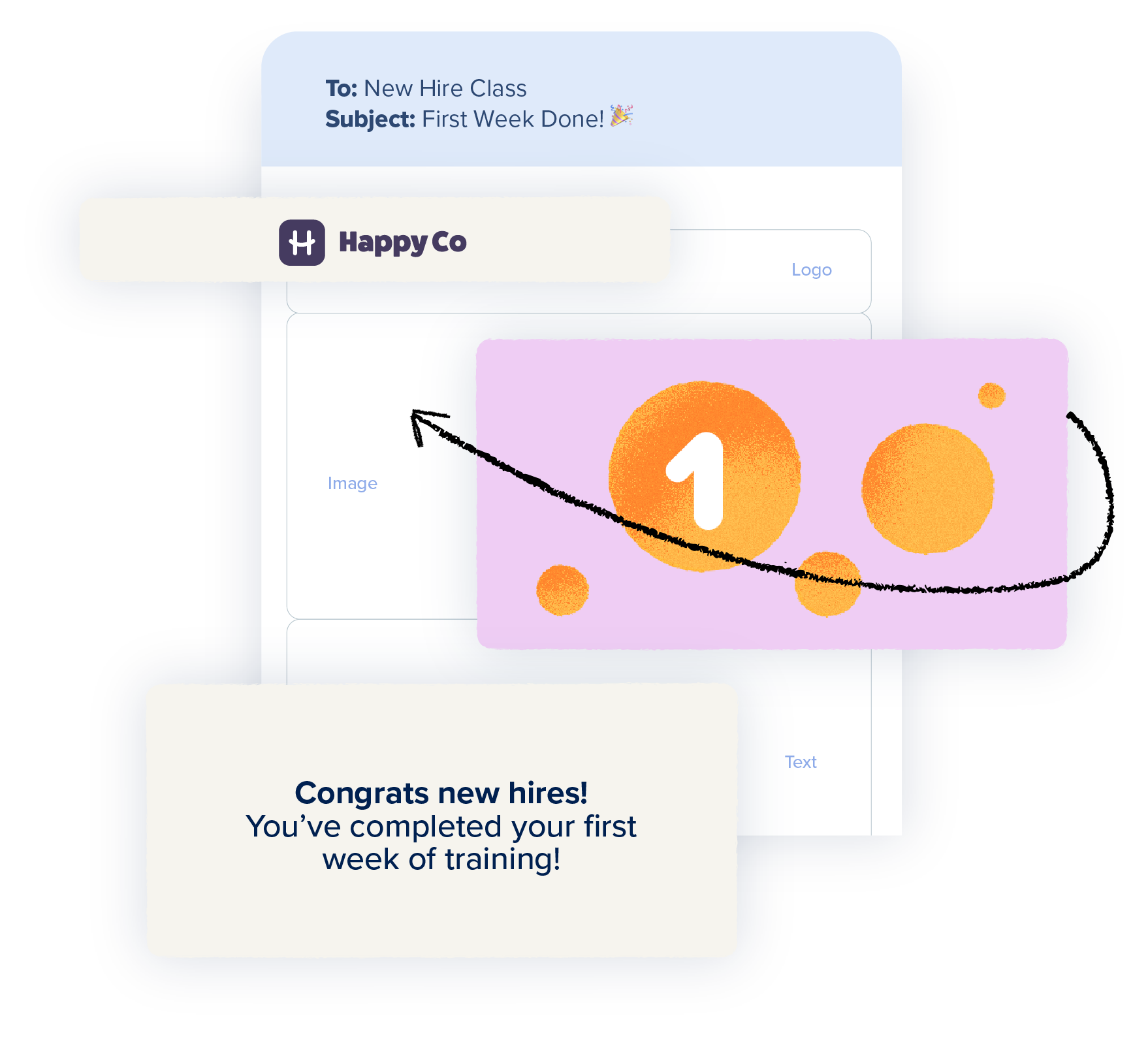
7.) Visibility
If there’s one truth we all know in internal communications, it’s that we know you need to get the message out more than once. That means more than one email, and certainly more than one channel. Hubspot isn’t set up for that kind of repetitive, campaign-oriented thinking; it’s set up primarily for one-off blast or automated marketing emails.
And though Workshop’s primary focus is on internal email, we’ve set up a system that makes it incredibly easy to re-iterate messages across all of your communications platforms: Slack, Sharepoint, Microsoft Teams, and even SMS. You can send customized notifications to any (or all) of these channels to boost the visibility of your email, and easily create follow-up messages to re-send to the employees who didn’t engage with it the first time.
Plus, with campaign data and the ability to filter analytics by department or role, it’s easy to see where there are opportunities for improvement, unengaged teams, or messages that just aren’t resonating…all critical pieces of information that’ll help better inform your internal communications strategy going forward.
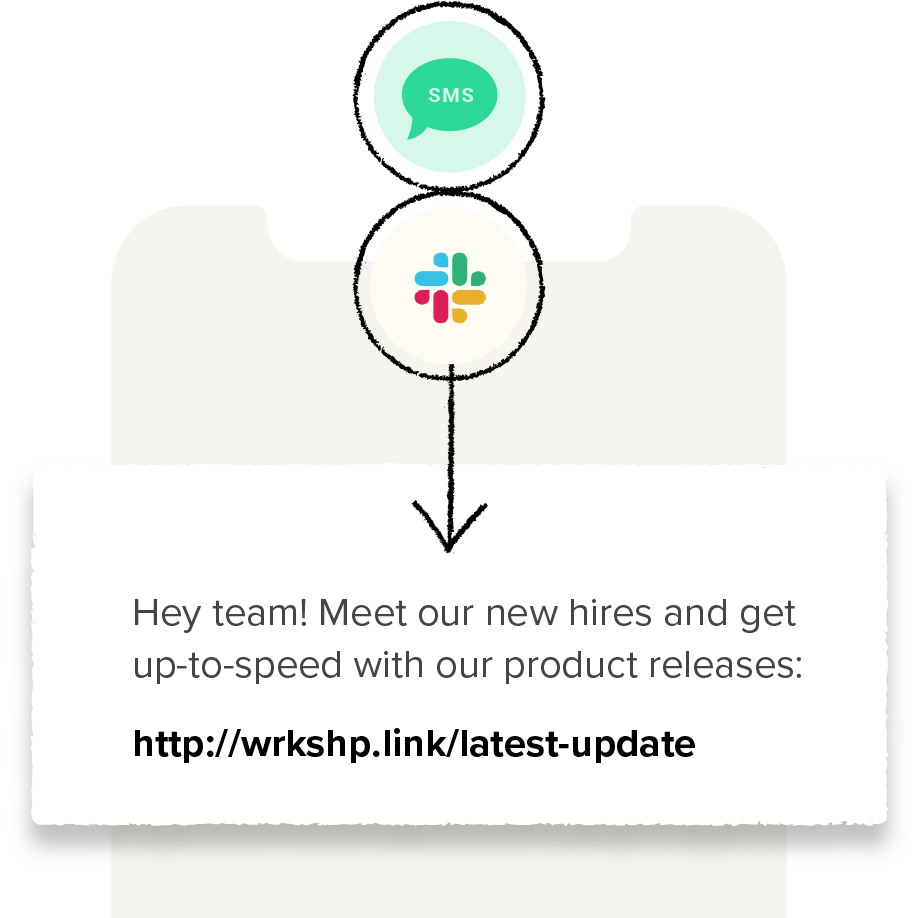
8.) Independence
Because the marketing team often “owns” Salesforce/Constant Contact/Hubspot/Marketo/etc., internal communications can very often feel like it’s stuck in a bottleneck. Whether it’s waiting for the email to be designed, for IT to update the distribution list, for your CEO to approve the test email, for the marketing team to send the email, to parse out the data on that recent send…it can be incredibly frustrating to feel like you’re dependent on the resources and time of other teams to achieve your results.
With Workshop, you not only have a tool tailored specifically for your unique needs, but you can also leverage it to strengthen relationships with key stakeholders. A dedicated internal email tool streamlines the process of creating on-brand designs (delighting the marketing team), sending to regularly updated distribution lists (reducing IT workload), obtaining approvals efficiently, and showcasing performance metrics (demonstrating ROI to leadership). Additionally, you can manage all aspects of your email campaigns, including creation, sending, measurement, and planning, within a unified platform.
9.) Miscellaneous features
One of our goals at Workshop is to make every internal email a great employee experience, so we’ve built in engaging, relevant features to help you do just that. You can embed GIFs, add videos, and even include surveys directly into the body of the email, so it’s super easy for you to get nearly instantaneous employee feedback. (Plus, you can filter through all this survey data easily after the email is sent; it’s such an impactful thing to deliver to the leadership team). These embeddable surveys don’t exist within an external marketing tool like Hubspot.
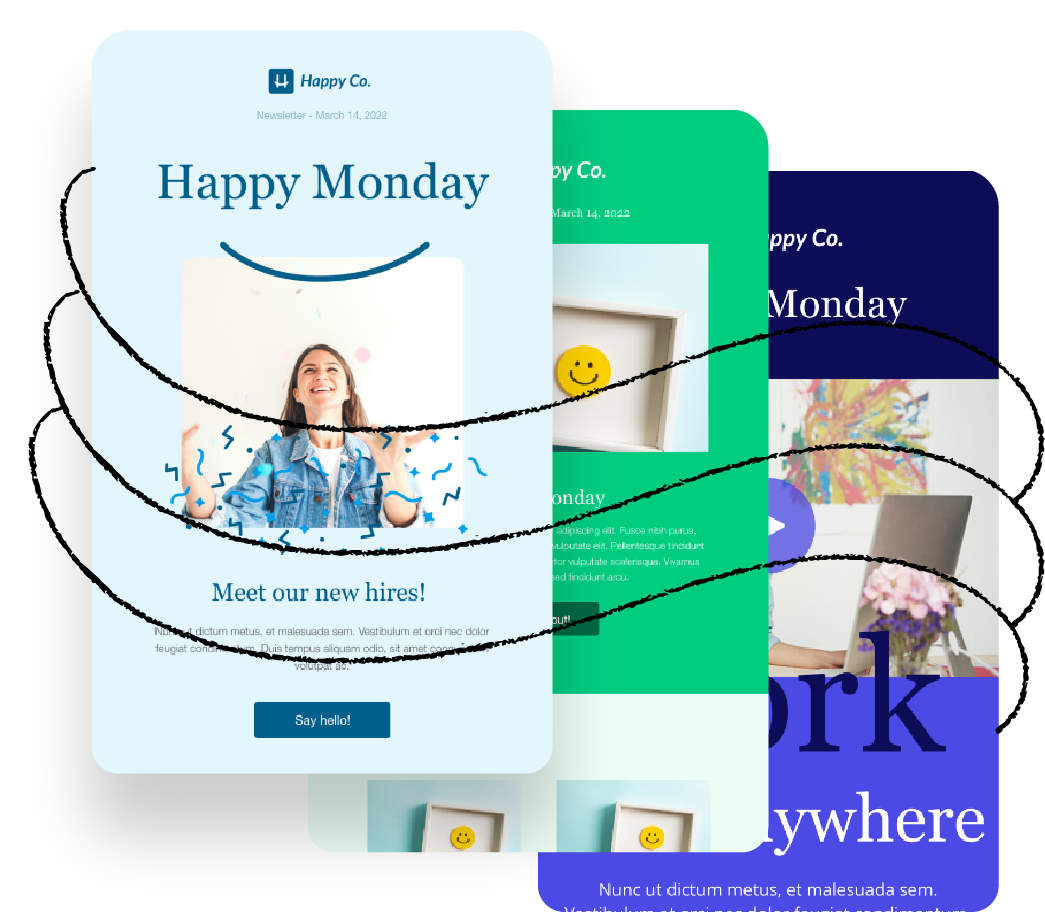
Another one of our favorite features? Campaigns, which gives you everything you need to create, collaborate, send, and measure internal emails and campaigns from one central place. You can see an upcoming calendar for cross-company communications, segment your email analytics by specific topics, and schedule all of your emails ahead of time. It’s the best way to switch from a reactive to a proactive internal communications strategy!
10.) Training and support
Last (but certainly not least), there’s a major difference between Hubspot and Workshop in terms of the onboarding, training, and support you receive. An external marketing tool like Constant Contact, Hubspot, or Marketo will always rely heavily on self-service support; it is very difficult to get someone on the phone for a technical issue, and often isn’t even possible unless you are on a very expensive plan. It’s also really difficult to navigate help docs related to design, distribution lists, etc.; I’ve found myself completely lost in old forum answers trying to solve for an issue with editing the alignment of an email. And if you’re new to Hubspot…well, the onboarding and training process can be incredibly overwhelming, especially if you aren’t familiar with HTML styling.
In contrast, every Workshop customer receives a dedicated account manager and full training to make sure your team is comfortable using our email editor from the very beginning. (Often, this training takes no more than 15 minutes.) We often collaborate with our customers on important new internal communications campaigns (rebrands, mergers & acquisitions, major policy changes, etc.) and will do everything we can to ensure you’re set up for success from the very beginning. Plus, we’re always available for support via phone, email, and chat, regardless of what plan size you choose. (You can find more detailed information about our pricing here.)
Alternatives to Hubspot for internal communications
If you’re going to do internal emails right, it’s important to choose a great tool. The absolute best email software for internal communications is just that: email software for internal communications. 😉 There are three options in this space:
- Workshop
- Bananatag (acquired a couple of years ago, now an absorbed part of Staffbase)
- Contact Monkey
All three of these are purpose-built for internal comms, have more engaging designs, offer analytics, and provide better management of your employee emails. Workshop and Bananatag both sync with your people data so you can create targeted messages and always have up-to-date distribution lists, and both provide multi-channel communication options; Contact Monkey only integrates with Gmail and Outlook. Bananatag and Contact Monkey both also offer a version of their platform for salespeople; Workshop is the only one that is built solely for internal communications.
Choose any one of these three options, and you’ll be set up for success as far as internal emails go!
How to make the case for dedicated internal email software
Of course, your marketing team needs email software to communicate with customers and prospects, and a tool like Constant Contact, Hubspot, or Marketo is absolutely perfect for that. We understand, however, that adding a second piece of email software (like Workshop) can feel like a big ask, even when the pros aggressively outweigh the cons.
There are typically four areas where we you can propose budget for a dedicated internal email tool, if you don’t already have a formal budget for internal communications:
- Employee engagement: Internal communication is an absolutely critical part of engaging your team. Whether it’s “employee experience” or “people” costs, we often find that a tool like Workshop fits squarely into this category, and is a much more practical purchase than many of the survey or engagement software on the market.
- HR: Many organizations use Workshop to run all of their communication campaigns for human resources, from new hire onboarding to open enrollment to DEI to employee resource groups.
- Operations: In terms of helping the business run more smoothly, there’s few things more impactful than internal communications! Logistically, Workshop is the tool for getting mission-critical information into the hands (and phones!) of employees everywhere, and we’re the go-to tool for all-company newsletters.
- Marketing: I’ve personally segmented 10% of the marketing budget for internal communications, primarily because I believe it to be a huge driver for our marketing efforts (especially when it comes to employee advocacy).
If you need additional help advocating for a bigger budget for employee experience and/or internal communications, we’ve put together a massive resource on that here!
The next step:
Learn more about Workshop and request a demo here!





